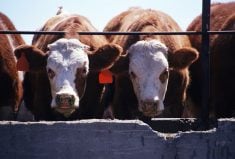Western Canadian feeder prices were not immune to the meltdown of financial and commodity markets last week. Buyers appeared to incorporate a risk discount due to uncertainty in beef demand over the next few months.
Compared to last week, larger groups of quality yearlings traded $3-$5 lower while smaller packages were down $4 to as much as $8. Yearling prices in Saskatchewan and Manitoba were down as much as $10 in some cases. Calves were relatively unchanged early in the week but by Friday, were trading $4-$6 below week-ago levels. Alberta packers were buying fed cattle at an average price of $248 on a dressed basis, down $5-$7 from last week. On a live basis, fed cattle were quoted at $148 in Alberta. Finishing feedlot pen closeout values are now about $12 below breakeven and losses on unhedged cattle are around $150-$180 per head. June live cattle futures dropped US$9.075 for the week and closed at a contract low of US$101.20.
Read Also

Huge crops in South America says analyst
Although there’s a debate over the size of the South American soybean crop, there’s little doubt that it will be an enormous one, said consultant Michael Cordonnier of Soybean and Corn Advisor in Hinsdale, Ill.
Heavier yearlings mirrored the price slide in the fed cattle market. In central Alberta, medium- to larger-frame tan steers weighing 930 lbs. reportedly sold for $170 while mixed steers averaging just over 800 lbs. were quoted at $180. In Manitoba, black steers averaging 800 lbs. valued at $166 and Charolais-blended heifers weighing 825 lbs. were quoted at $151. Larger supplies of backgrounded cattle are coming on the market at this time of year and finishing feedlots were on the defensive throughout the week.
The market structure for calves was harder to define, with prices quite variable across the Prairies. In central and southern Alberta, medium- to larger-frame steers around 700 lbs. were valued from $180 to as high as $188, with heifers trading at a solid $20 discount. In Manitoba, Charolais-based steers weighing 650 lbs. were quoted at $196; in central Saskatchewan, medium- to larger-frame black steers weighing 640 lbs. were valued at $204 while in central Alberta, similar-quality steers averaging 650 lbs. dropped the gavel at $201. Steady demand was noted on calves under 600 lbs. but buying interest for featherlight calves appeared to evaporate this past week.
Feeder markets are expected to remain under pressure moving forward. Failure of the live cattle futures to stabilize will keep finishing feedlots on the defensive. Statistics Canada’s livestock inventory report had the number of beef cows as of Jan. 1 down 2.6 per cent from January 1 of 2019 while the number of calves was slightly above year-ago levels. This may be due to the increase in feeder cattle imports from September through December 2019.
— Jerry Klassen manages the Canadian office of Swiss-based grain trader GAP SA Grains and Produits Ltd. and is president and founder of Resilient Capital, specializing in proprietary commodity futures trading and market analysis. Jerry consults with feedlots on risk management and writes a weekly cattle market commentary. He can be reached at 204-504-8339 or via his website at ResilCapital.com.
















